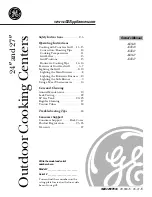
11
Consumer Support
Care and Cleaning
Troubleshooting T
ips
Operating Instructions
Safety Instructions
Fº
Cº
10
50
10
0
150
200 250
30
0
35
0
Before Cooking for the First Time with Your New Grill
Before cooking on your gas grill for the
first time, “burn off” the grill to rid it of
any odors or foreign matter as follows:
1.
Remove cooking grids and warming
rack and wash in mild soap and water.
Ignite the burner.
2.
Close the lid and operate the grill for
20 minutes with the control knobs set
at medium.
3.
Turn the gas off by closing the LP tank
valve. Turn the control knobs to
OFF
.
4.
Let the grill cool down, then replace
the grids.
The grill is now ready for cooking.
Cooking with your gas grill.
www.GEAppliances.com
Preheating
It is necessary to preheat the grill with
the lid closed for a short time before
cooking certain foods. Foods that
require a
HIGH
cooking temperature
need a preheat period of 6–10 minutes;
foods that require a lower cooking
temperature need only a period of
2–5 minutes. There is no need to
preheat for casseroles or other foods
that require slow cooking.
Lid Position
The position of the lid during cooking is
a matter of personal preference, but the
grill cooks fastest, uses less gas, and
controls the temperature best with the
lid closed. A closed lid also imparts a
smokier flavor to meat cooked directly
on the grid, and is essential for smoke,
rotisserie and convection cooking.
Cooking Temperatures
HIGH
Use this setting only for fast warm-up,
for searing steaks and chops, and for
burning food residue from the cooking
grids and Flav-R-Wave® after the cookout
is over. Rarely, if ever, do you use the
HIGH
setting for extended cooking.
MEDIUM
Use this setting for most grilling,
roasting, and baking, and for cooking
hamburgers and vegetables.
LOW
Use this setting for all smoke cooking,
rotisserie cooking, and when cooking
very lean food such as fish.
These temperatures are approximate only
and vary with the outside temperature and
the amount of wind.
NOTE:
When cooking by the convection or
rotisserie method, use a meat thermometer
for best results.


























